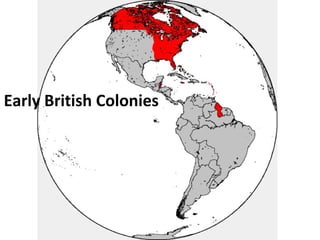
early British colonies.pdf
- 2. Jamestown • 1607: Jamestown, the first permanent English settlement in North America • Funded by Joint-stock companies • Joint-stock companies allowed several investors to pool their wealth in support of a colony that they hoped would yield a profit
- 3. Economics of settlement: • Tobacco becomes a highly profitable crop in Virginia • Indentured servants become the supply of labor to harvest crops • Colonists coming from Europe who could not afford the voyage costs would agree to a limited term of servitude in exchange for passage, food, and shelter
- 4. Early Representative Government: • Virginia House of Burgesses served as the first representative body in colonial America • Mayflower Compact was crafted by the pilgrims as they sailed to North America in 1620; created a civil government and pledged loyalty to the king • Fundamental Orders of Connecticut in 1639, extended voting rights to a greater number of white males in the colony The Mayflower Compact, a painting by Jean Leon Gerome Ferris which was widely reproduced through much of the 20th century
- 5. Puritans: • Created a “New England” • After the Church of England was formed, the Puritans believed that the church had kept too many Catholic rituals • The Puritans wanted to “purify”, or reform the church by eliminating all traces of Catholicism The Westminster Assembly in a Victorian history painting by John Rogers Herbert.
- 6. Puritans Continued… • Some Puritans, called separatists, wanted to separate from the English church • In 1620, a small group of these separatist Puritan families founded the Plymouth Colony. This became the second permanent English colony in North America • These separatists, or pilgrims were also responsible for creating the Mayflower Compact
- 7. Massachusetts Bay Colony: • Other Puritans who were not separatists began to feel the burdens of increasing religious persecution, political repression, and dismal economic conditions • In 1630, a group of Puritans established the Massachusetts Bay Colony and founded Boston as their capital • The Puritans believed they had a special covenant, or agreement, with God. They felt it was their duty to create a moral society • Puritan leader was John Winthrop
- 8. Quakers: • A Protestant sect that held services without formal ministers, allowing any person to speak as the spirit moved him or her • They dressed plainly, refused to defer to persons of rank, opposed war, and refused to serve in the military • Quakers settle Pennsylvania and are led by William Penn • Penn wanted to establish a good and fair society
- 9. England and its Colonies prosper: • Thirteen Colonies- throughout the 1600 and 1700’s more British colonies were founded • Some leaders of these colonies received charters, or a document issued by a monarch or other authority creating a public or private corporation The 1606 grants by James I to the London and Plymouth companies. The overlapping area (yellow) was granted to both companies on the stipulation that neither found a settlement within 100 miles (160 km) of each other.
- 10. England’s Colonies continued… • The colonies exported a rich variety of raw materials, such as lumber and furs, and in return they imported the manufactured goods that England produced • Together, the colonies represented a rich variety of people, skills, motives, industries, resources, and agricultural products
- 11. The Thirteen Colonies: • New England Colonies: Massachusetts, New Hampshire, Connecticut, Rhode Island (Economic activities: shipbuilding, lumber, mining, fishing) • Middle Colonies: New York, Delaware, New Jersey, Pennsylvania (Economic activities: furs, shipbuilding, rum, beer, agriculture) • Southern Colonies: Virginia, Maryland, North Carolina, South Carolina, Georgia (Economic activities: tobacco, lumber, agriculture)
- 12. Mercantilism • Mercantilism is a theory that states, a nation can increase its wealth in two ways: by obtaining as much gold and silver as possible and by establishing a favorable balance of trade, in which it sold more goods than it bought • The key to Mercantilism was the establishment of the colonies An imaginary seaport with a transposed Villa Medici, painted by Claude Lorrain around 1637, at the height of mercantilism
- 13. Navigation Acts: • Navigation Acts were passed to tighten colonial trade, these acts enforced the following rules: – No country could trade with the colonies unless the goods were shipped in either colonial or English ships – All vessels had to be operated by crews that were at least three quarters English or colonial – The colonies could export certain products, including tobacco and sugar-and later rice, molasses, and furs- only to England – Almost all goods traded between the colonies and Europe first had to pass through an English port • The Navigation Acts obviously benefited England • It proved to be good for colonists as well (spurred colonial shipbuilding and industry)
- 14. Growing Spirit of Self-Determination • The colonies were developing a taste for self- government that would ultimately create the conditions for rebellion • Colonial governments were chartered with a governor appointed by the crown, advisory council, and local assembly elected by landowning white males • Northern and Southern colonies were developing distinct societies, based on sharply contrasting economic systems